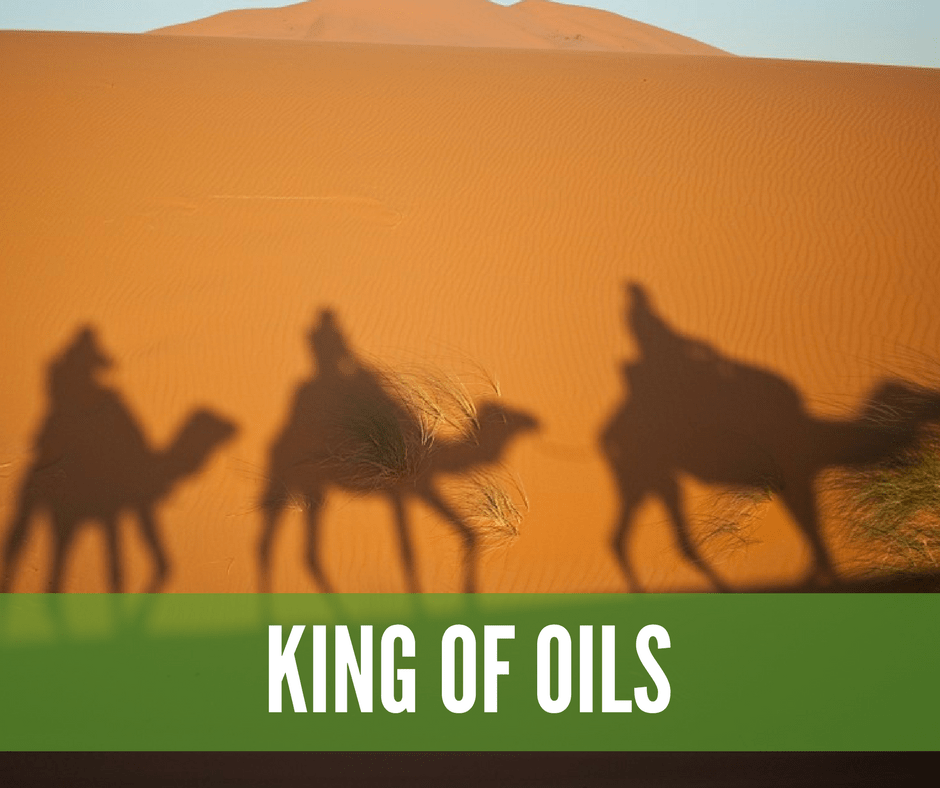
Renowned as one of the most prized and precious ESSENTIAL OILS, FRANKINCENSE is also known as the “King of Oils.”
In addition to its fame as a Kingly gift in the New Testament, the Babylonians and Assyrians would burn FRANKINCENSE in religious ceremonies, while the ancient Egyptians used FRANKINCENSE resin for everything from perfume to salves for soothing skin.
“FRANKINCENSE has been traded on the Arabian Peninsula and in North Africa for more than 5000 years. A mural depicting sacks of FRANKINCENSE traded from the Land of Punt adorns the walls of the temple of ancient Egyptian Queen Hatshepsut, who died circa 1458 BC.” (https://infogalactic.com/info/Frankincense#History). This would be during the time of MOSES, and 12 years before the Exodus and crossing of the Red Sea.
FRANKINCENSE is one of the incenses described in the Scriptures. The FRANKINCENSE used by the Jews, Greeks, and Romans, is also known by the Hebrew-derived word, Olibanum. In the Old Testament, we are told that worshippers of Yahweh from Sheba come with FRANKINCENSE:
“all those from Sheba shall come.
They shall bring gold and frankincense,
and shall bring good news, the praises of the Lord.” (Isaiah 60:6; see also Jeremiah 6:20).
FRANKINCENSE is of course also mentioned in the Song of Solomon (4:12–14):
“A garden locked is my sister, my bride,
a spring locked, a fountain sealed.
Your shoots are an orchard of pomegranates
with all choicest fruits,
henna with nard, nard and saffron, calamus and cinnamon,
with all trees of frankincense…”
FRANKINCENSE, as part of a special blend of incense, was offered on the altar of incense in the Tabernacle. Interestingly, that altar was made of Gold, and the anointing oil poured on the priests and furniture in the tabernacle included Myrrh. So, Gold, FRANKINCENSE, and Myrrh. If that trio sounds familiar, it should.
FRANKINCENSE also appears in Exodus 30:34: “And the Lord said unto Moses, Take unto thee sweet spices, stacte, and onycha, and galbanum; these sweet spices with pure frankincense: of each shall there be a like weight…” Here, God is directing Moses in the creation of the holy anointing oil.
FRANKINCENSE was also used to anoint the grain offering (Leviticus 2:1, 16; 6:15) and the tabernacle bread (Leviticus 24:7).
When burnt, FRANKINCENSE has a fragrant smell, and the Bible prophesies that the nations would burn incense to the name of God (Malachi 1:11). Incense in general is also specially associated with prayer (Psalm 141:2; Luke 1:10; Revelation 5:8, 8:3).
FRANKINCENSE was often linked with Myrrh. In addition to the reference to the Tabernacle above, see Song of Solomon 3:6, and 4:6. And of course, these were two of the three gifts offered to Jesus by the Persian Magi.
NOTE: Did you know you can take an entire Class on OILS OF THE BIBLE? Ask for details if interested.
QUESTION – ARE YOU FAMILIAR WITH ALL THE BIBLICAL TEXTS QUOTED ABOVE? IF NOT, NOTE ONE THAT WAS NEW TO YOU.